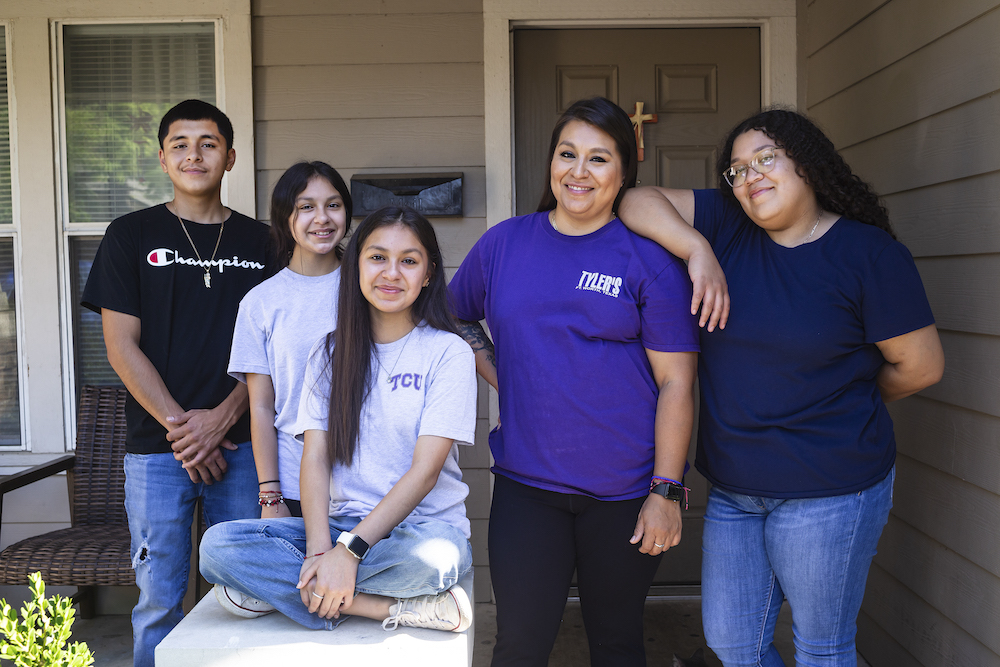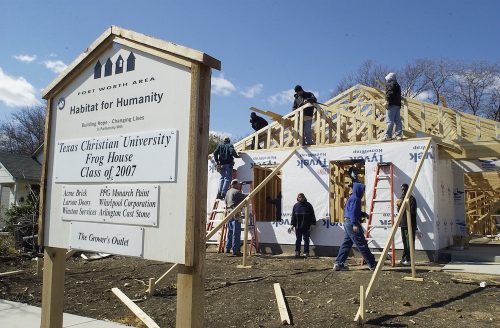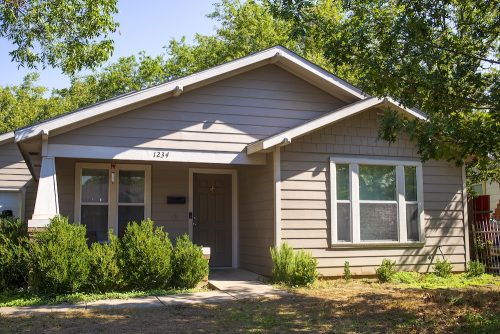FrogHouse Raised Walls and Leaders
A Habitat for Humanity project changed everyone who touched it.

In their junior year, TCU's class of 2009 worked with Habitat for Humanity on the FrogHouse project, building a new home for Olga Samano (second from right). Samano currently resides in the house with her children (left to right) Brandon, twins Alexa and Alyssa and her oldest daughter, Natalie. Photo by Mark Graham
FrogHouse Raised Walls and Leaders
A Habitat for Humanity project changed everyone who touched it.
In 2007, Olga Samano was a 25-year-old single mother living in her parents’ house with her two children and her two sisters. Seven people shared a three-bedroom, one-bathroom Fort Worth home.
Samano said the thought, “I can’t do this anymore — I have to get my life together” looped in her mind.
She turned to Habitat for Humanity, a nonprofit homebuilding program that serves people in need of affordable housing.
Meanwhile at TCU, a group of juniors was settling into their roles with FrogHouse, a then 3-year-old formal partnership between TCU and Habitat for Humanity. Each FrogHouse team spent an academic year building a house for a family — from the first dollar to the last nail.
Student leaders for Samano’s home planned to raise $50,000 during the fall semester and build her a house 2 miles east of campus in the spring.
The project “was massively impactful,” said Eric Tabone ’08, the executive director of Samano’s project. “We would start fall semester with no money, and in a matter of six to eight months we’re giving a family a house.”
FrogHouse also gave students a dose of reality, Tabone said. “We got to see a side of what the real world actually looks like. Oftentimes we were within this bubble and didn’t see what it looked like on Berry [Street] 10 blocks away.”
When Habitat for Humanity told her she’d been approved for a home, “I literally started crying at work because I just knew that that was meant for me,” said Samano, who works in billing at John Peter Smith Health Network. “I was going to be able to have room for my kids and myself. It was just the most wonderful feeling ever.”
Raising Money and Walls
TCU’s relationship with Habitat for Humanity stretches back to the 1990s. Before FrogHouse, the university’s student chapter had offered alternative spring break excursions during which students helped build houses in places including Los Lunas, New Mexico, and Americus, Georgia.

Habitat for Humanity approved Samano for a home, and the student volunteers went to work on the lot 2 miles east of campus. TCU’s affiliation with Habitat for Humanity began in the 1990s. Courtesy of TCU Archives
In 2005, TCU staff members, seeking to improve the student experience, assigned a part of the university’s mission to each class: To educate individuals (first-years) to think and act as ethical leaders (sophomores) and responsible citizens (juniors) in the global community (seniors).
Juniors interpreted their responsible citizenship mantle as an opportunity to give back to Fort Worth, said Jared Cobb ’11 EdD, who led the class’s experience. Among them: One dance major went to an elementary school in a disadvantaged area to teach ballet during gym class.
The FrogHouse partnership, which started in 2005 and ended in 2010, involved hundreds of students and taught skills from raising money to wielding a hammer.
“I remember thinking, ‘Wow, this is special. This is really happening — here we go.’ ”
Matt Owens
Matt Owens ’07 helped lead the inaugural FrogHouse project in 2005-06 as the fundraising director.
With other juniors, he wrote letters to the TCU community asking for donations. One of the first checks came from Marcia Schubert ’80, who had encouraged Owens to consider enrolling at TCU.
“I remember thinking, ‘Wow, this is special. This is really happening — here we go,’ ” said Owens, who put the experience to work in a fundraising job two years after graduation and now runs operations for a family foundation. “We began the process in earnest, knowing this is big: The success of the junior year project is squarely on us, and if it doesn’t get funded, it doesn’t get done.”
The students serving Samano decided on a letter-writing campaign as well. They also put collection jars around campus and hosted a Halloween costume contest.
Chris Volpe ’09, the director of fundraising for Samano’s home, asked students to skip one latte and donate that money to FrogHouse.
But the funding goal turned out to be a bigger mark than anticipated, Volpe said. “It was grueling. … It’s sink or swim — raise $50,000 or you’re not building a house.”
TCU’s administration kicked in the final $15,000, which allowed the building phase to begin in the 2008 spring semester.
Volunteers filled construction slots, usually on Fridays and Saturdays. Sometimes a fraternity, athletics or alumni group would fill the whole day’s volunteer schedule. Tabone said the project was good for “bringing people from the entire TCU network together.”
Tabone, who later founded BBE Languages, a Bogotá, Colombia-based communications training business, worked alongside Samano on construction days; Habitat requires its recipients to participate in the construction.
Samano said the TCU juniors, just a few years younger than she was, brought enthusiasm and energy to build days. “Especially on a Saturday early in the morning — you’re a college student — who wants to be at someone else’s house trying to help them build it? They chose to be here.”
Samano took a day off work to raise the first wall of her new house.
She started envisioning the future as she drove by the construction site at night. She tried to decipher the maze of framing on her Saturday volunteer days. Though afraid of heights, she worked on the roof, thinking, “I’m actually putting a roof over my head.”
At the ceremony to hand over the keys, Volpe and Tabone watched as Samano’s son, Brandon, and daughter, Natalie, with wide smiles and bright eyes, explored their new house.
Giving and Receiving
The FrogHouse team changed the future for Samano’s family, which later included twin girls. The TCU students emerged from the project changed as well.
“When I got to step back and see the done house and see the reaction of the family getting the house, I knew it was going to be life-changing,” Volpe said. “You don’t realize how it puts you on a different trajectory.”

In their junior year, TCU’s class of 2009 worked with Habitat for Humanity to help build Olga Samano’s house. Photo by Mark Graham
Volpe used examples of his FrogHouse victories and blunders in job interviews.
“A lot of the skills that I learned at FrogHouse really translated to what I’m doing now: presenting in front of people, teaching people, engaging a team,” he said. “It was such a valuable real-life experience of running a project. I see so many direct similarities in how I run projects now to how we did FrogHouse.”
The entrepreneurial fire ignited during Volpe’s junior year led to his later opening a coffee shop during a national recession and choosing a job at a risky startup company over an established organization. He is now a senior director at a software company.
For Samano, the new house was the beginning of a new life.
Sometimes after work she would pull into her driveway and sit in the car to gaze at her house. “Thank you, God. This is our home,” said Samano, who still lives in the house. With the help of some committed TCU students, “I was able to do this for my kids and give them a home of their own.”

Your comments are welcome
Comments
Related reading:
Alumni, Features
A Public Defender’s Fight for a Man’s Freedom
Attorney John Thomas’ innovative defense and commitment to his cause helped his client’s release.
Alumni, Features
Helping Companies Build Social Responsibility Initiatives
Josh Simpson, whose career started at Google, now works for Capital One Financial Corp.